French Canadian Heritage in St Norbert Manitoba
St. Norbert Provincial Heritage Park illustrates pre-World War I life in a Manitoba French-Canadian agricultural community
St. Norbert Provincial Heritage Park illustrates how a natural landscape used for hunting, fishing, and camping by native peoples evolved into a French-speaking Métis development, then a French-Canadian agricultural community. The park is located at the junction of the Red and LaSalle Rivers, approximately three kilometres south of the Winnipeg Perimeter Highway in St. Norbert, a bilingual community on the outskirts of Winnipeg, Manitoba.
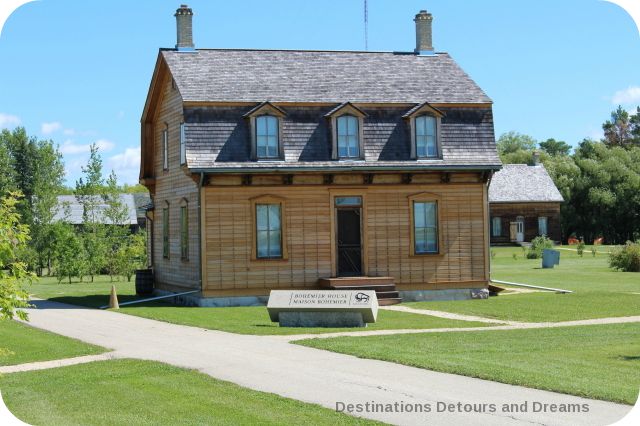
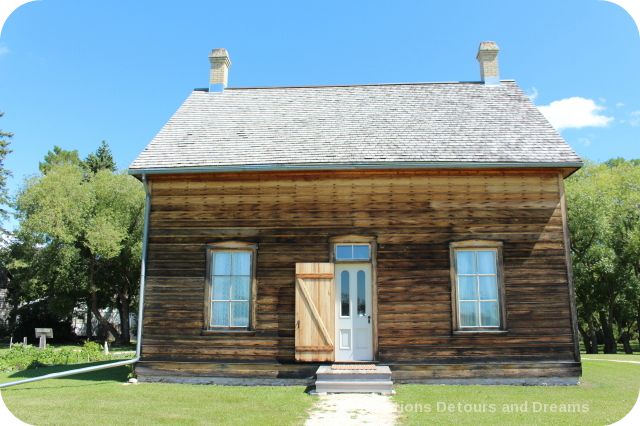
Joseph Turenne built a log house on a river lot in St. Norbert in 1871. The house was well-known to travellers who used the nearby ferry crossing. Turenne and his wife lived in this two bedroom home for ten years with the surviving five of the eight children born to them during that period. When they moved to St. Boniface in 1882, newcomers often rented the house from the parish priests and stayed there until they became more established. Later, the Grey Nuns occupied the house. The house remained occupied and in use until 1971.
Turenne was a Québec professional recruited by the Roman Catholic clergy to hold public office in Manitoba shortly after it became part of the Confederation of Canada. Being fully bilingual, he translated laws for the Métis. My guide asked me a question. If a farm had belonged to a family for generations but they had no written deed to prove that, did they still own the land after the area became part of Canada? The answer was yes, but many did not know that and lost their land in negotiations. This was the kind of situation Turenne helped prevent.
The inside is restored as per the late 1800s. As photos are not allowed inside the houses, I cannot show you visually any of the details of the restoration which provides insight into life in those time. The Turennes were not rich, but were more well-off than the average. There was a parlour, which would have been heated and used only for company. Two bedrooms, one of which was used as Turenne’s office for the first years they lived there. Later it was the girls’ bedroom. The boys slept in the hall. A cellar where vegetables were stored over the winter. A kitchen which would have been the main living area. No bathroom. Even in the middle of winter, the outdoor outhouse would have been used, with chamber pots available for overnight or when one was ill.
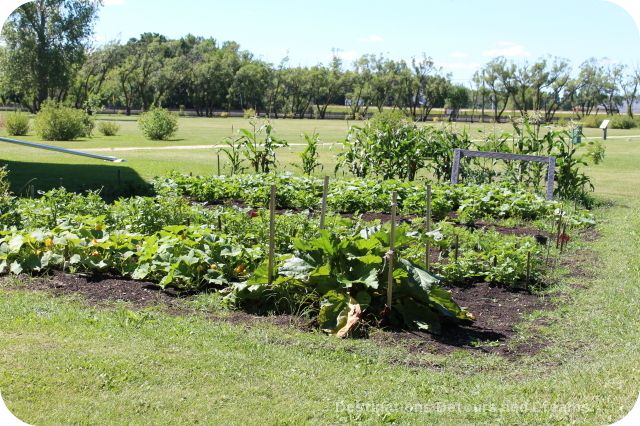
My guide told me the garden was not 100% accurate to the times. Root vegetables would have been the mainstay, items that could be stored over the winter. Corn would not have been planted. The only corn grown in Manitoba at that time was in the southern-most edge of the province and it was feed corn. It was only later when hybrids and corn with shorter growing seasons were introduced that corn for human consumption was grown in Manitoba. She said that corn would have been grown many years prior and the natives had knowledge of corn, but when a mini ice-age occurred about five hundred years ago, the growing season became too short for corn
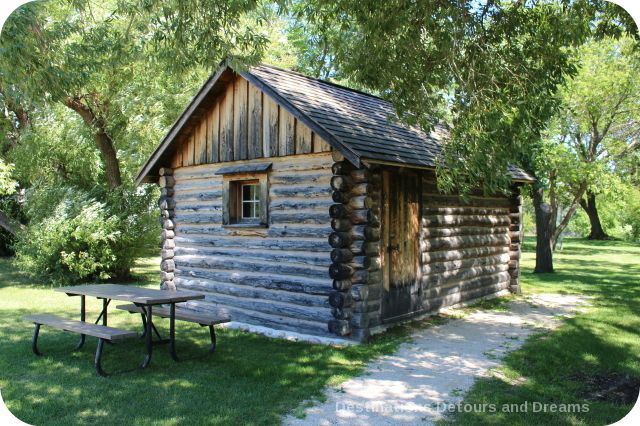
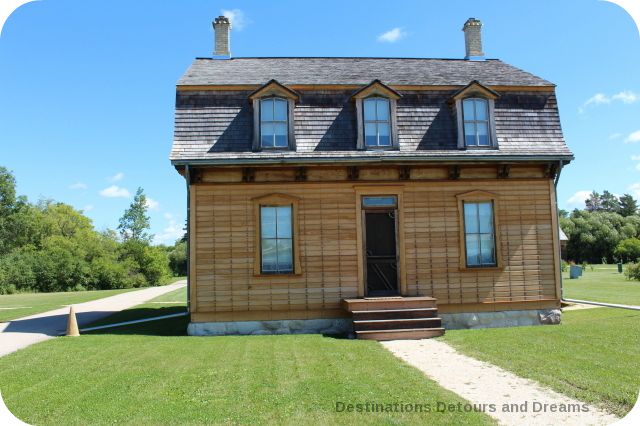
It was a style more common to Québec, where the Bohémiers came from.
One of the newcomer families who stayed in the Turenne House for a while was that of Benjamin Bohémier and his wife Marie-Louise, who came from Québec to farm in 1883. They owned land in what is now the Fort Richmond sub-division of Winnipeg. They constructed a gambrel-roofed home. Two of the Bohémier children lived in the house and continued to market garden until 1973, when the land was purchased to build an apartment block. The two were in their eighties at the time.
The interior of the house has been restored to recreate the lifestyle of the family in the time period of 1906 to 1912. The Bohémier family was a wealthy family and this house is larger than the Turenne house. It contains original wood floors and paneling. The wallpaper in the front parlour and dining room (a company-only space) is a replica of the original wallpaper, discovered during restoration after peeling off layers of subsequent paper. Most of the furnishings are original to the family. When the house was restored for use in the park, grandchildren donated pieces passed down to them. A Gobelins tapestry from Fance hangs in the parlour.
An interesting feature of this house is the indoor outhouse on the second floor. It is vented to the outside to keep smells out of the house. The youngest daughter had the job of emptying the toilet pots. My guide told me that the room would not have been used regularly – only on the coldest of winter days or when someone was ill. For most of the time, the outdoor outhouse was used. When the land was sold and the house moved, it still did not have indoor plumbing.
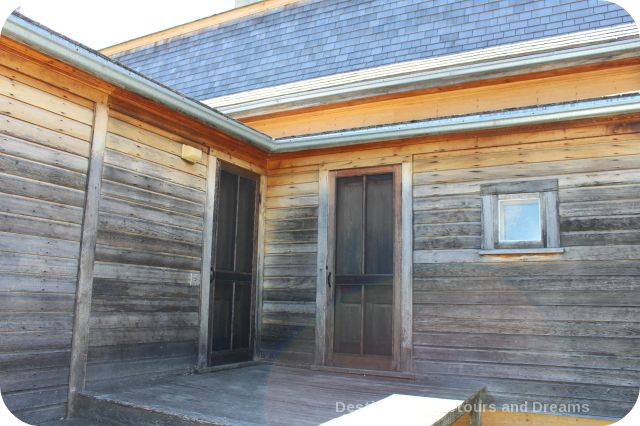
The front entrance of the house opens into the parlour and formal dining room. This entrance would have been a company-only entrance. The back entrance would have been used by the family. At the back there was also an entrance to a larder, where food and preserves would have been stored.
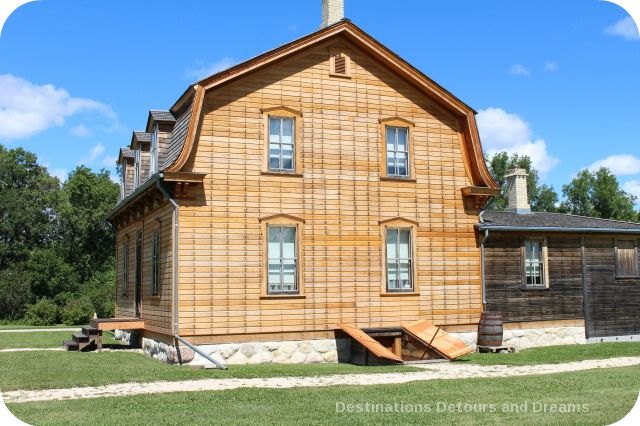
The most expensive item in the house was the large and fancy stove. Like the stove in the Turenne house, it would have been taken apart and moved in and out of the summer kitchen at the start and end of summer.
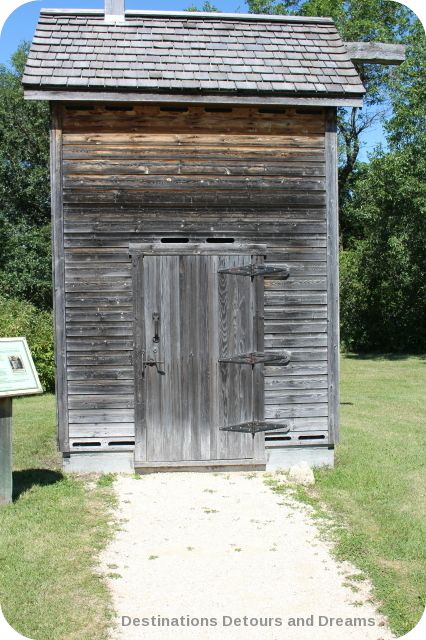
Pulleys raised blocks of ice to the upper level. Perishables in sealed containers were stored on shelves below, along with a pan to collected melted water. Ice chips would be used to make ice cream for a Sunday treat.
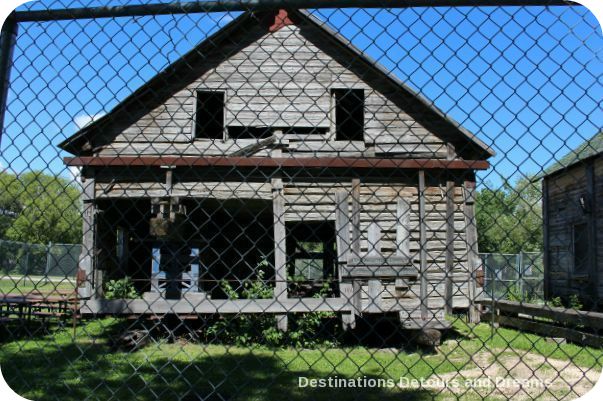
Another house, not restored, sits in the park. It belonged to Pierre Delorme and was built in the mid-1850s in St. Adolphe, south of St. Norbert. It is an example of Red River frame construction. The home was used as a way station for travellers on the Pembina Trail between Fort Garry and St. Paul, Minnesota. Pierre Delorme was a close ally of Louis Riel and the first member of Parliament for the riding of Provencher. The house was occupied until 1950, when it suffered significant flood damage. Plans to restore it for the park stopped it from being torn down in the 1980s. However, it turned out damage was too extensive and restoration costs prohibitive. It now sits surrounded by a chain fence, to stop the house from taking anyone with it when it eventually falls down.
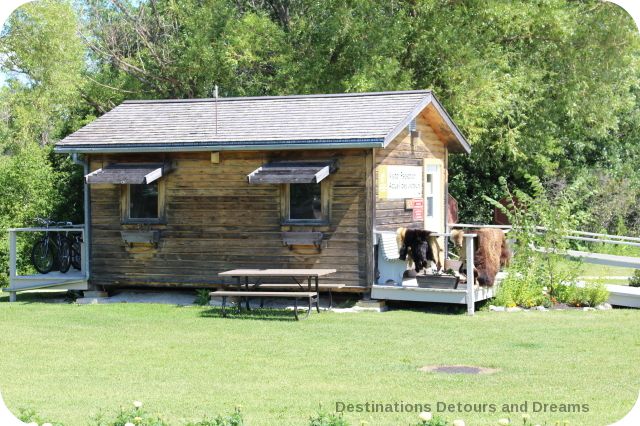
St. Norbert Provincial Heritage Park is located at 40 Turnbull Drive, just off Pembina Highway. Although the park site is open daily through the summer, the interior of the homes can only be seen via guided tours. In July and August of 2024, tours were scheduled for 6:30pm to 7:30pm on Wednesdays and Thursdays. Check the Manitoba Parks site for tour hours. Admission is free.
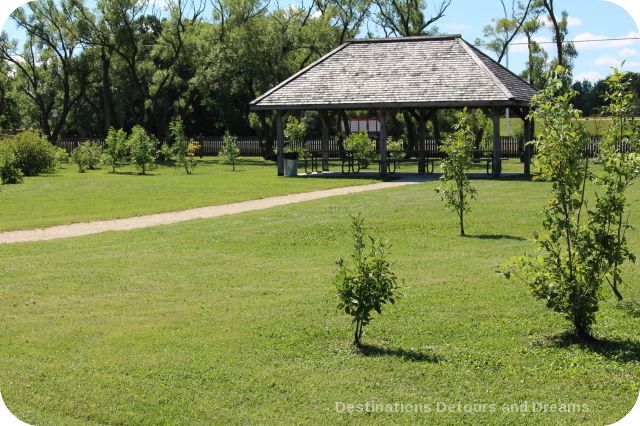
If you enjoyed this post, sign up for Destinations Detours and Dreams monthly e-newsletter. Get behind the scenes information and sneak peeks ahead in addition to a recap of the month’s posts.

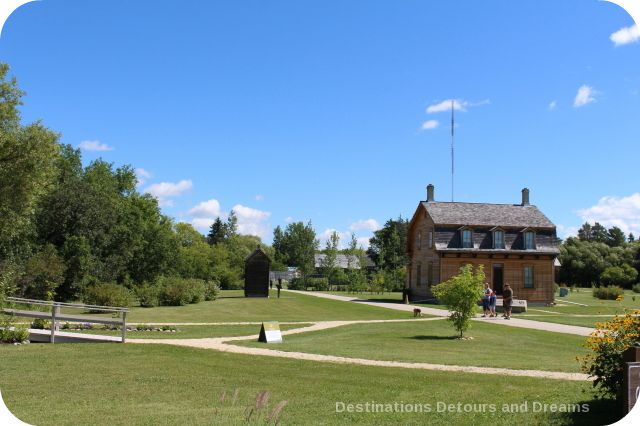
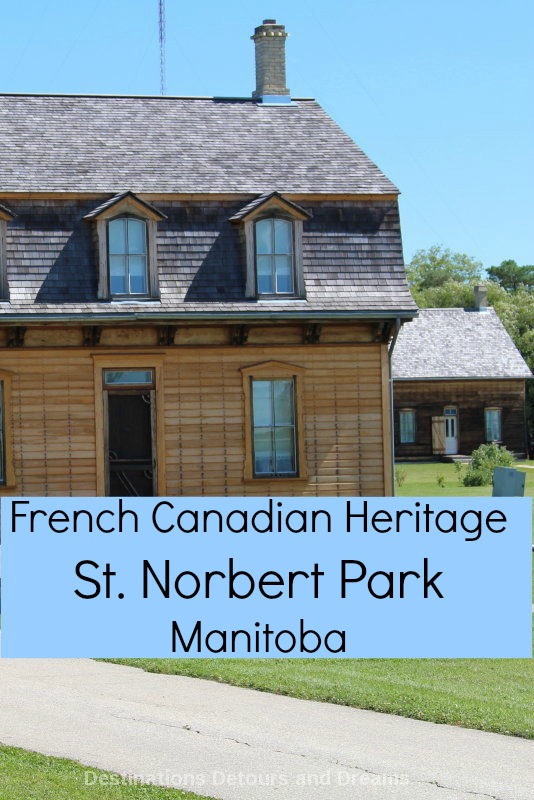
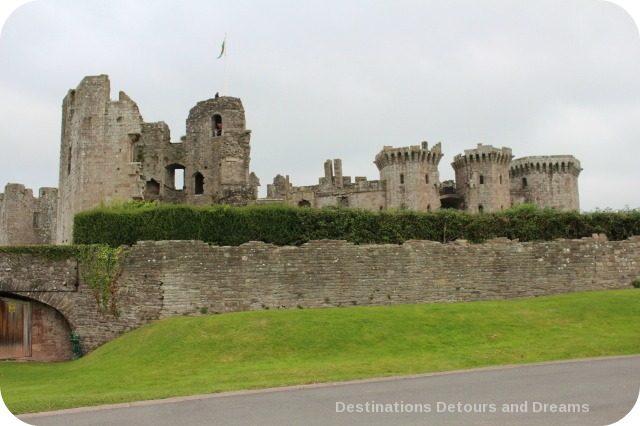
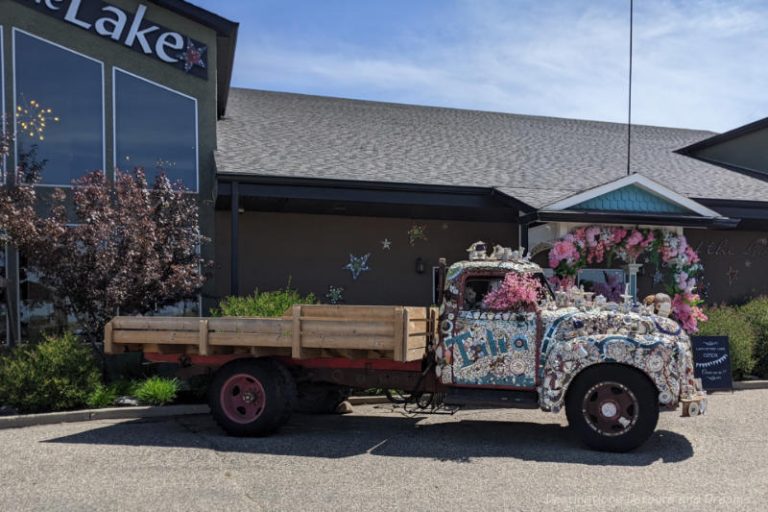
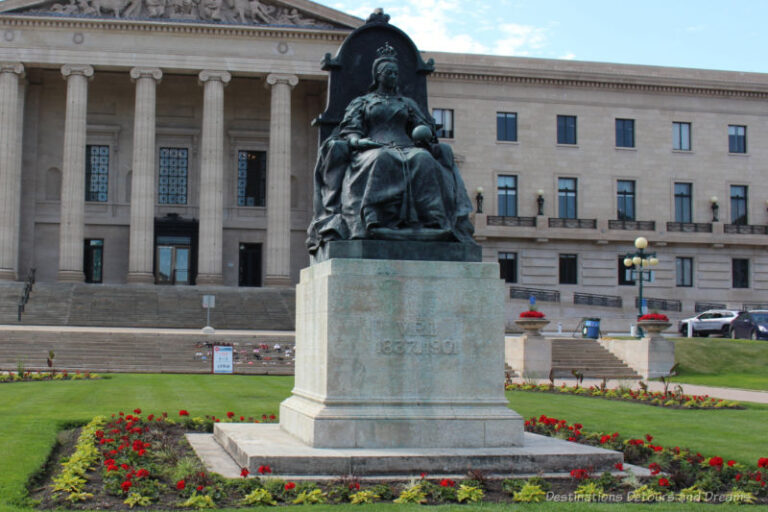
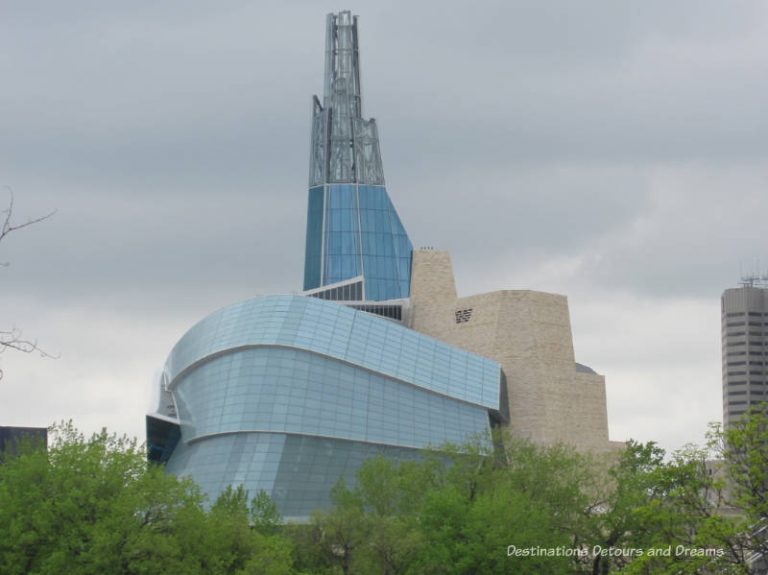
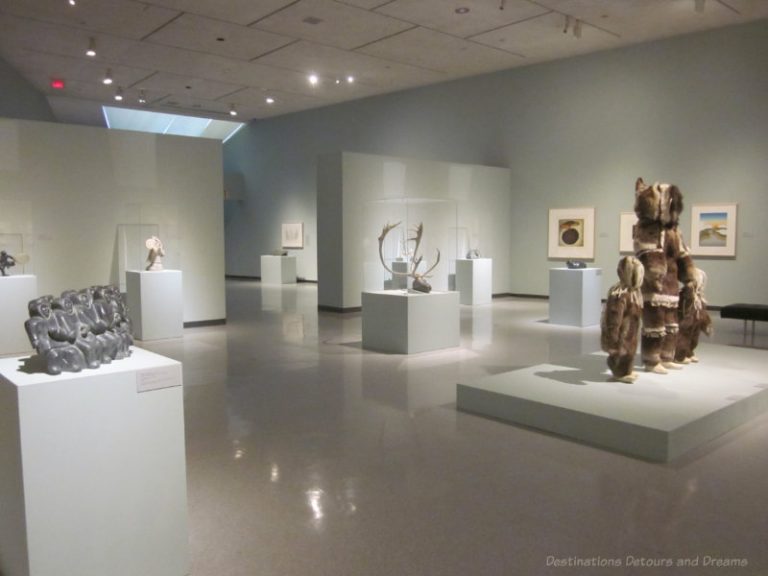
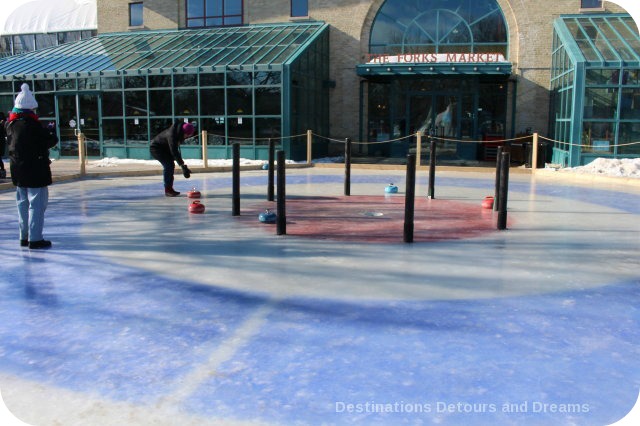
This looks beautiful! The exterior of the cabins is so well preserved, it would have interesting to see the interiors. Too bad they wouldn’t allow photos. I love that these things are preserved for historical purposes. Maybe we can learn more about self-sufficiency by keeping these things alive:) The gardens are a prime example.
Jacquie, the restoration work has been done well – the inside looks as good as the exterior.
I love places like St. Norbert Provincial Heritage Park and taking a tour of the homes and grounds would be fascinating for the glimpse it allows into the lives of the people who lived in them so many years ago. It’s really too bad that your readers can’t see pictures of the inside but you did a great job of describing the rooms as well as sharing some very interesting trivia. Until this post I’d never heard of an indoor outhouse! Anita
Anita, the indoor outhouse was a bit of a surprise. This family was fairly well off financially. I guess it was an early version of our modern in-door plumbed bathrooms.
Lovely buildings. I love the photos too. The buildings seem well-maintained. Thanks for sharing.
Thanks Sabrina.
Like Anita and Richard, we love places like this where you can literally walk through history. I’d not heard of the St. Norbert Provincial Heritage Park before and this was a most interesting tour.
I’ve driven past St. Norbert Heritage Park many times over the years. I’m glad I decided to stop in this summer.
Didn’t know there was a French Canadian presence in Manitoba, I love old buildings. Thanks for sharing St. Norbert Provincial Heritage Park!
Manitoba has a significant Francophone population. The first Europeans to reach the west in the 18th century were Francophone. There are numerous Francophone communities throughout southern Manitoba. St. Boniface, now a part of Winnipeg, is home to one of the largest Francophone communities west of the Great Lakes.
I love these old buildings. What a great place to spend a day. People often think that the French are only in Quebec, but you can go anywhere in Canada I think and find small French settlements. In Nova Scotia, there are a number of French communities close to Yarmouth.
Nancie, I suspect there are French communities across most of Canada, more in some areas than others. There are many French towns in southern Manitoba.
Never thought the French influence extended to Manitoba. I wonder how they are able to preserve everything here since admission is free? And I wonder how far you had to go from your place to reach St.Norbert. As usual, you did a great job of describing everything,outhouse, refrigerators, stove, etc.!
Carol, there is a significant French population in Manitoba. The Park started when the Fort Garry Historical Society saved the two houses (now restored) and donated them to the province. To the best of my knowledge, the park receives government funding as well as support from the historical society. St. Norbert is at the south end of Winnipeg, a continuation of the city. The park lies on the outskirts of the city and isn’t very far from my house at all (10 minutes).
As a French Canadian (Québec) I love discovering bits of history we didn’t learn at school. I always enjoy your posts and your descriptions.
Thanks Nathalie. If you went to school in Québec, did you learn much about French-Canadian history in other parts of Canada?
St. Norbert Provincial Heritage Park sounds like a good way to get a glimpse into life at that moment of history. I was also surprised that there were French Canadians in Manitoba.
Rachel, it was a good glimpse into life at that time. And my guide had a lot of interesting information.
I’m always intrigued by places like the St. Norbert Provincial Heritage Park that preserve old buildings even if they have to move them. Like many others who left comments, I also had no idea that Manitoba had Francophone settlers. Do they have French schools as a public school option today?
Suzanne, yes there are French schools as a option. There is a Francophone school division with schools across the province geared to those raised in French. And there are French-immersion schools in other divisions across the province geared for those whose primary language is English. Some immersion attendees have French ancestry on one side of the family, although they have not been raised in French. Others just want the opportunity to become bilingual. My daughter attended French-immersion public schools.
We love Canada but have never made it to Manitoba. Hope to change that someday.
Veronica, I would love to see you guys in Manitoba some day.
This is beautiful Donna. Thank you for taking me on a virtual tour to Manitoba. Never been to Canada but have friends and family that recently relocated to Canada. I have no choice but will visit soon x
Where in Canada have your friends and family relocated to? Canada is large and diverse – each area is a little different and worth visiting, in my opinion. I hope you do get to see some of the country when visiting friends and family.
I just love visiting these places. Isn’t it wonderful that people make the effort to preserve their heritage in places like St. Norbert Provincial Heritage Park. Thanks for sharing it, Donna.
Thanks Yasha
What a fascinating post. So interesting to see the French heritage expand outside Quebec as you describe. The Bohemier house is quite similar in style to older buildings I saw recently in Quebec
Glad you enjoyed the post. The Bohemier house is unusual for this part of the country. I’ve not seen another in that style, but the guide told me it was a common style in Quebec.
What a fascinating history and a diverse history that St. Norbert Provincial Heritage Park has had. It appears that they ave done a very sympathetic restoration. We will be going to Quebec and will look for this style of housing.
This was my childhood home. Since it was my father that made it into what could be described as a “park” by planting over 1000 trees – (all those mature large trees that are not on the riverbank) – I sure hope by now there is a plaque about his 30 years of hard work. We had a log home made out of a settler’s cabin and the old outbuildings – also log. But in the government’s wisdom, they chose to bulldoze it. Breaks my heart. I’m probably the one person who cannot bear to look at these other houses, even though it is a worthy effort. At least the riverbanks where I played as a child are not changed. If there is no plaque acknowledging my father, his name was H. H. G. Moody, a Winnipeg architect. He bought the place in 1946 and we went through two floods in that house before the floodway came in. He sold it to the NDP government in about 1976.
Jane, H.H.G. Moody is a well-known name in Winnipeg. He made significant contributions to the architecture within the city. I honestly cannot remember now if there was a plaque there for him or not. I will have to stop in again sometime this summer and check. I wonder what the rationale was for bulldozing the trees. I can understand how it breaks your heart. I grew up in a small town south of Winnipeg. While I don’t remember your property specifically, I do remember the stretch north from Turnbull Drive to the bridge into St. Norbert being so pretty when we drove into the city. I also remember flooding in the area. Thanks for this information.